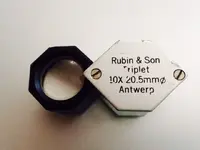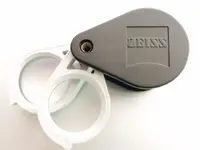scaupus
Hero Member
- Joined
- Apr 20, 2011
- Messages
- 889
- Reaction score
- 523
- Golden Thread
- 0
- Location
- Not too far from a beach
- Primary Interest:
- All Treasure Hunting
I finally found the Great White Whale that I'd been pursuing for the last year or so, on this Labor Day weekend, when I scooped up a 3 diamond engagement ring with a nearly 1 carat center diamond in a 14k white gold setting. I'd committed myself to finding a big diamond over a year ago, and finally, I succeeded!
A jeweler who has a shop inside a supermarket near my house checked them with an electronic tester and said they were diamonds. She looked at them with a loupe and she said she didn't see any occlusions. I was thrilled. I contacted my metal detecting buds. Cellular phones were buzzing with the news, and photos of my find were circulating among a small circle of treasure hunting club pals and other trusted buds. Guys were asking me where and how I found it. I now felt part of an elite group...the multi-thousand dollar diamond ring club.
And I had a very amusing story to add about the first jeweler I had taken it to, who had tested my ring and offered me $20 for it. He would not answer me when I asked him what it was, though he had tested it with a machine. He had touched the tip to the ring several times, looking at his machine, touching again and again. I thought I had seen 2 lights flash, and then the third light, a red one next to the word moissanite, had stayed on. From where I was standing, I couldn't read the words next to the yellow and green lights. The jeweler had continued to examine the ring briefly after the test, before offering me $20 for it.
I refused the offer, and left rather confused. I had heard of moissanite, but had never heard of anyone ever metal detecting one before. I thought they were pretty rare. I still had to get it tested by a jeweler who would communicate with me.
After doing some research, though, I don't really need to see another jeweler. I will still get it tested, at a pawn shop, just to confirm my observations, but I already know the stones are indeed moissanites.
[PS. yesterday, Tuesday, a young gal working at a pawn shop tested the stones with a moissanite tester for me and confirmed all 3 stones are moissanite. So now I know for sure that double refraction is the way to tell without a machine. Another characteristic of moissanites that I am sure can bu used as a clue just looking at one with the naked eye before you check it with a loupe, is that they refract a lot more than a diamond and this gives them a rainbow sparkle. That, and the darker, yellowr/green color cast together should be enough for you to suspect moissanite.]
Moissanites sounds like some ancient order of eastern rite monks, but in fact moissanites, as most of you probably know, are a diamond simulant, almost all of which on the market today are synthetic, a process that went commercial only a few years ago. Synthetic moissanites combine the virtues of being an excellent diamond simulant with being very durable. They are even more fiery and sparkly than diamonds, and are more durable [9.25 on mohs scale] than even rubies and sapphires [9 on mohs scale]. Cubic zirconia [mohs 8] is not nearly as hard.
A good one the size of a one carat diamond will cost at new retail a few hundred dollars, whereas an equivalent diamond would cost several thousand. Many pawn shops discount the added value of the moissanites when they price moissanite jewelry, lending only on the gold melt value. I think they do this because moissanites are still not widely known and accepted by the public.
I also found out that there are three ways to distinguish moissanites from diamonds.
The first way is with a moissanite electronic tester. It will tell you if you have a moissanite, and some can also tell you if you have a diamond. There are machines that can tell you if you have a diamond or a CZ but will call a moissanite a diamond. Obviously, such a machine is worse than useless if you are testing an unknown stone that happens to be a moissanite, as it will call it a diamond. They work based on the rate of heat dispersion. It is this type of machine that my "good-news" jeweler used on this ring. These machines were very reliable before moissanites began being manufactured synthetically in recent years, since natural moissanites are very rare, but synthetic moissanites are for sale everywhere now, and the old machine can't be relied upon anymore to tell you if you have a real diamond.
The second way to tell a moissanite is by color. Moissanites are darker than diamonds. They tend to be yellower and/or greener than diamonds. Side by side with a diamond of good color, say a "G" color diamond, you may be able to tell the difference. But personally, I cannot rely on my color sense alone to tell me if a stone is a moissanite.
Luckily, there is another way we can visually distinguish moissanites from diamonds quite easily, and it is 100% certain, so long as you know what you are looking for. Moissanites are birefringent, meaning they refract,,,bend... a light ray that enters its surface in such a way that it splits into 2 separate rays. This is called double refraction. Diamonds refract light with just a simple bending of the one ray of light. That is called Single Refraction. CZ's are also single refraction.
If you look through one of the side facets of the moissanite gem with a good loupe or magnifier - that is through one of the crown facets, to use the correct jeweler's term - you will see some lines of light that look doubled, that is, two lines of light very close together, seemingly parallel to each other. That is birefringence, and if you see that, it is a dead give-away that you have a moissanite.
I find that a loupe of at least 8x is sufficient. I also have used an old german made photographic enlarger lens for the job. The old enlarger lens is of very high optical quality, so even though it doesn't enlarge as much as my 8x cheap plastic loupe, the excellent resolution and contrast allow me to see the double refraction quite clearly.
The first jeweler who offered me $20 was certainly low-balling me, hoping my ignorance would play his way. The melt value right now of the gold alone is about $90. A similar used three stone 14k moissanite anniversary ring with a 6mm central moissanite stone just sold at auction on ebay for about $225. All the other sellers currently offering similar used 3 stone rings on ebay are asking from $400 to $900. Retail new you can figure maybe $1500 at a big name retail store.
Well, a 14k white gold ring with 3 moissanites, with a total carat weight of about 1.5 carats is certainly a decent enough find. By the way, a one carat diamond is the same size as a .75 carat moissanite. Moissanites are a bit lighter.
Just to note what else I found this weekend:
1, a well made 925 silver ring marked AJ. I saw a recent sale of a similar AJ 925 ring on ebay for $50. There are a few more on sale now asking in the $60 range.
2. a goldplated .925 child's ring. Looks like a butterfly.
3, a pair of ray bans. Frame and lenses in very good condition, very few scratches or defects, except the lenses are a bit milky. Maybe a metallic coating on the lens reacted with the saltwater. Too bad.



A jeweler who has a shop inside a supermarket near my house checked them with an electronic tester and said they were diamonds. She looked at them with a loupe and she said she didn't see any occlusions. I was thrilled. I contacted my metal detecting buds. Cellular phones were buzzing with the news, and photos of my find were circulating among a small circle of treasure hunting club pals and other trusted buds. Guys were asking me where and how I found it. I now felt part of an elite group...the multi-thousand dollar diamond ring club.
And I had a very amusing story to add about the first jeweler I had taken it to, who had tested my ring and offered me $20 for it. He would not answer me when I asked him what it was, though he had tested it with a machine. He had touched the tip to the ring several times, looking at his machine, touching again and again. I thought I had seen 2 lights flash, and then the third light, a red one next to the word moissanite, had stayed on. From where I was standing, I couldn't read the words next to the yellow and green lights. The jeweler had continued to examine the ring briefly after the test, before offering me $20 for it.
I refused the offer, and left rather confused. I had heard of moissanite, but had never heard of anyone ever metal detecting one before. I thought they were pretty rare. I still had to get it tested by a jeweler who would communicate with me.
After doing some research, though, I don't really need to see another jeweler. I will still get it tested, at a pawn shop, just to confirm my observations, but I already know the stones are indeed moissanites.
[PS. yesterday, Tuesday, a young gal working at a pawn shop tested the stones with a moissanite tester for me and confirmed all 3 stones are moissanite. So now I know for sure that double refraction is the way to tell without a machine. Another characteristic of moissanites that I am sure can bu used as a clue just looking at one with the naked eye before you check it with a loupe, is that they refract a lot more than a diamond and this gives them a rainbow sparkle. That, and the darker, yellowr/green color cast together should be enough for you to suspect moissanite.]
Moissanites sounds like some ancient order of eastern rite monks, but in fact moissanites, as most of you probably know, are a diamond simulant, almost all of which on the market today are synthetic, a process that went commercial only a few years ago. Synthetic moissanites combine the virtues of being an excellent diamond simulant with being very durable. They are even more fiery and sparkly than diamonds, and are more durable [9.25 on mohs scale] than even rubies and sapphires [9 on mohs scale]. Cubic zirconia [mohs 8] is not nearly as hard.
A good one the size of a one carat diamond will cost at new retail a few hundred dollars, whereas an equivalent diamond would cost several thousand. Many pawn shops discount the added value of the moissanites when they price moissanite jewelry, lending only on the gold melt value. I think they do this because moissanites are still not widely known and accepted by the public.
I also found out that there are three ways to distinguish moissanites from diamonds.
The first way is with a moissanite electronic tester. It will tell you if you have a moissanite, and some can also tell you if you have a diamond. There are machines that can tell you if you have a diamond or a CZ but will call a moissanite a diamond. Obviously, such a machine is worse than useless if you are testing an unknown stone that happens to be a moissanite, as it will call it a diamond. They work based on the rate of heat dispersion. It is this type of machine that my "good-news" jeweler used on this ring. These machines were very reliable before moissanites began being manufactured synthetically in recent years, since natural moissanites are very rare, but synthetic moissanites are for sale everywhere now, and the old machine can't be relied upon anymore to tell you if you have a real diamond.
The second way to tell a moissanite is by color. Moissanites are darker than diamonds. They tend to be yellower and/or greener than diamonds. Side by side with a diamond of good color, say a "G" color diamond, you may be able to tell the difference. But personally, I cannot rely on my color sense alone to tell me if a stone is a moissanite.
Luckily, there is another way we can visually distinguish moissanites from diamonds quite easily, and it is 100% certain, so long as you know what you are looking for. Moissanites are birefringent, meaning they refract,,,bend... a light ray that enters its surface in such a way that it splits into 2 separate rays. This is called double refraction. Diamonds refract light with just a simple bending of the one ray of light. That is called Single Refraction. CZ's are also single refraction.
If you look through one of the side facets of the moissanite gem with a good loupe or magnifier - that is through one of the crown facets, to use the correct jeweler's term - you will see some lines of light that look doubled, that is, two lines of light very close together, seemingly parallel to each other. That is birefringence, and if you see that, it is a dead give-away that you have a moissanite.
I find that a loupe of at least 8x is sufficient. I also have used an old german made photographic enlarger lens for the job. The old enlarger lens is of very high optical quality, so even though it doesn't enlarge as much as my 8x cheap plastic loupe, the excellent resolution and contrast allow me to see the double refraction quite clearly.
The first jeweler who offered me $20 was certainly low-balling me, hoping my ignorance would play his way. The melt value right now of the gold alone is about $90. A similar used three stone 14k moissanite anniversary ring with a 6mm central moissanite stone just sold at auction on ebay for about $225. All the other sellers currently offering similar used 3 stone rings on ebay are asking from $400 to $900. Retail new you can figure maybe $1500 at a big name retail store.
Well, a 14k white gold ring with 3 moissanites, with a total carat weight of about 1.5 carats is certainly a decent enough find. By the way, a one carat diamond is the same size as a .75 carat moissanite. Moissanites are a bit lighter.
Just to note what else I found this weekend:
1, a well made 925 silver ring marked AJ. I saw a recent sale of a similar AJ 925 ring on ebay for $50. There are a few more on sale now asking in the $60 range.
2. a goldplated .925 child's ring. Looks like a butterfly.
3, a pair of ray bans. Frame and lenses in very good condition, very few scratches or defects, except the lenses are a bit milky. Maybe a metallic coating on the lens reacted with the saltwater. Too bad.
Amazon Forum Fav 👍
Last edited:
Upvote
2






